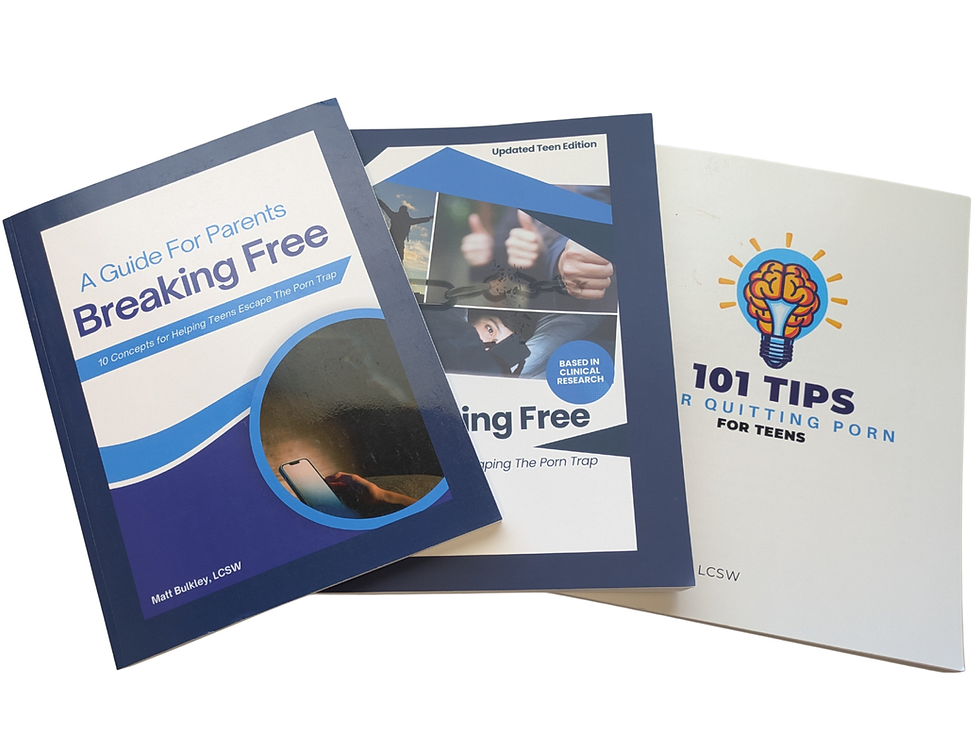Helping Your Teen Overcome Pornography Addiction: Understanding Emotional Triggers
- Matt Bulkley

- Jul 12
- 4 min read
As a parent, discovering your teen is struggling with pornography addiction can feel overwhelming. You might wonder why it’s happening or how to help without pushing them away. The truth is, pornography often serves as a quick escape for teens grappling with intense emotions. By understanding the emotional triggers fueling this behavior, you can guide your teen toward healthier ways to cope. Below, we explore five common triggers—inadequacy, discouragement, boredom, stress, and frustration—and offer practical strategies to support your teen, grounded in research and real-world insights.
1. Inadequacy: Escaping the Comparison Trap
Teens today navigate a world of constant comparison, amplified by social media’s polished images of “perfect” lives. Feeling less smart, attractive, or popular can chip away at their self-worth, driving them to seek relief. A 2023 study in the Journal of Youth and Adolescence found that teens who frequently compare themselves to others are 60% more likely to experience anxiety, often turning to pornography as a temporary escape from feelings of inadequacy.
How to Help: Shift your teen’s focus from others’ highlight reels to their own growth. Celebrate small victories—like improving a grade, helping a friend, or learning a new skill. Research from Counseling Psychology Quarterly (2021) shows that tracking personal achievements can reduce feelings of inadequacy by 25%, weakening the pull of escapist behaviors. Try asking, “What’s one thing you’re proud of today?” to encourage a positive mindset. Open conversations about social media’s unrealistic standards can also help them see they’re not alone in feeling “less than.”
2. Discouragement: Overcoming the Sting of Setbacks
Adolescence is full of challenges—whether it’s struggling with schoolwork or navigating social dynamics. When efforts don’t yield quick results, teens can feel discouraged, believing they’ll never succeed. A 2020 Journal of Adolescent Health study found that discouraged teens are twice as likely to turn to addictive behaviors like pornography to escape feelings of failure.
How to Help: Remind your teen that setbacks are a normal part of growth. Share stories of your own challenges to show that perseverance pays off. A 2022 Psychology Today article noted that teens with supportive adults who model resilience are 30% less likely to rely on quick fixes like pornography. Encourage them to stick with a hobby or goal, praising their effort rather than just results. Help them find activities they enjoy, like art or sports, to replace discouragement with a sense of accomplishment.
3. Boredom: Filling the Void with Purpose
Boredom isn’t just an idle moment—it’s a state of disengagement that teens often fill with instant gratification. A 2019 study by Harvard researchers Dan Gilbert and Timothy Wilson revealed that many young people would rather endure mild electric shocks than sit alone with their thoughts, showing how uncomfortable boredom can be. For teens, pornography is an easy, always-available way to fill that void.
How to Help: Encourage your teen to take charge of their time by exploring new interests. Activities like sports, music, or volunteering can boost dopamine naturally, according to a 2023 Addictive Behaviors Reports study. Create a “boredom jar” filled with fun ideas—like sketching, calling a friend, or trying a new recipe—to make choosing engagement exciting. Frame boredom as an opportunity to create, not a gap to fill with screens, and model this by limiting your own mindless scrolling.
4. Stress: Managing the Pressure Cooker
Teens face a whirlwind of pressures—grades, friendships, family expectations, and future uncertainties. Chronic stress can push them toward quick relief, with pornography acting as a fleeting escape. A 2021 Journal of Behavioral Addictions study found that chronic stress increases the likelihood of addictive behaviors by 50%, as teens try to ease the grip of stress hormones like cortisol.
How to Help: Equip your teen with lasting stress-management tools. Teach simple techniques like deep breathing, prioritizing tasks, or taking a walk, which can lower cortisol levels, per a 2022 Neuroscience News report. Create space for open conversations by asking, “What’s feeling heavy right now?” and validate their emotions without judgment. A 2020 Brain and Behavior study showed that teens with strong emotional outlets are 40% less likely to turn to escapist habits. Modeling these techniques yourself reinforces their value.
5. Frustration: Channeling Anger Constructively
Frustration often hides deeper pain, like disappointment or helplessness, and can lead teens to lash out or withdraw. When conflicts or unmet expectations pile up, pornography can become a way to numb the anger. A 2019 Journal of Clinical Psychology study linked chronic frustration to a 40% higher risk of addictive behaviors as teens try to avoid processing their emotions.
How to Help: Guide your teen to express frustration in healthy ways. Suggest journaling, talking to a trusted friend, or engaging in physical activity to release tension—methods shown to reduce impulsivity, per a 2021 Behavioral Brain Research study. Model healthy anger management by admitting when you’re upset and sharing how you cope. Create a safe, judgment-free space for your teen to vent, reinforcing that their feelings are valid but don’t have to lead to destructive habits.
Building a Path Forward
Helping your teen navigate pornography addiction starts with understanding the emotions driving their behavior. By addressing inadequacy, discouragement, boredom, stress, and frustration, you can empower them to find healthier ways to cope. Be patient—change takes time, and your support makes all the difference. Listen without judgment, model resilience, and encourage small steps toward growth. Together, you can help your teen build a stronger, more confident future.
Resources for Parents:
Explore family counseling or support groups for pornography addiction.
Check out the Recovery Toolbox for Teens.
Check out Star Guides Treatment Center.
By addressing the root causes and offering practical solutions, you’re not just helping your teen overcome addiction—you’re equipping them with skills to thrive.










Comments